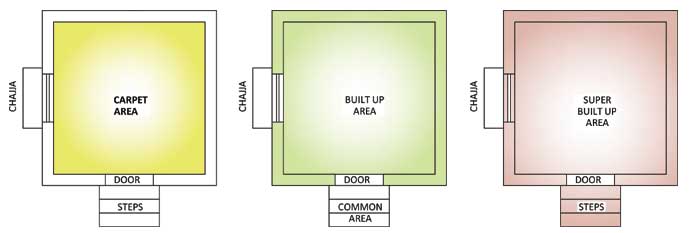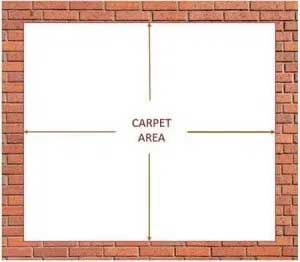How to Calculate Carpet Area, Built Up Area and Super Built Up Area
Purchasing a house is unlike any other experience. It’s a pleasure to create an oasis of calm in today’s bustling world. For most people, homeownership is an ambition that they wish to realize, and nothing can compare to the thrill you feel when you can at last call a place your own. Now, doesn’t it appear simple to acquire real estate?
Choose the region and type of structure you like, then pick the number of bedrooms. While the first half of your purchasing experience is undoubtedly essential, it’s also crucial to understand that the search for home entails a lot of technical jargon that you must be familiar with.
Of course, falling in love with a property on the spot is completely acceptable, but we must consider a few important factors. We must consider every element of the transaction, from value for money to square footage to long-term plans for the house and even our own long-term goals.
The number jargons you are going to face while making the decision to buy a flat would be overwhelming, especially for those who don’t even know the difference between the carpet area and the built up area. Not necessarily we all know the terms used in the real estate market, but a little education is necessary when you are going to buy your first flat.
Generally based on the price of the constructed area, the flat you are about to buy is charged for the total saleable area which includes lots of areas other than your living room, bedrooms, kitchen, toilet or balcony. To know what are you paying for, take a look at the most common area calculations used in the real estate market.
Have a look at boundary wall design with grill which is stylish yet safe for your house, farmhouse.
What is Carpet Area?
Consider the measurements from wall to wall; here you will exclude the area covered by the walls. In simpler words, if you cover the inside of your house with a carpet then the entire covered area would be the carpet area. It is the actual floor area in your flat that is called the carpet area.
Carpet Area Means in Brief:
The size of your house is primarily determined by its carpet area. Because carpet area is the most dependable indicator of how big the home is, the number itself provides an excellent idea on how big it is. As a result, you should always inquire about the carpet area when purchasing a home or renting it from someone else.
It’s the volume of living space, corridors, bathrooms, and kitchens that have been utilized up. The carpet area excludes balconies, flower beds, and terraces.
Carpet area is usually around 70% of the total built area of a home.
Have a look at gate pillar design with photos here and choose the best while getting your house constructed.
How To Calculate Carpet Area?
The first step is to determine the dimensions of each room in your house. Include the width and length of every space in this calculation.
Once you have a list of every room’s square footage, add them all up to get the total carpet area for your house. This number does not include any non-carpeted areas, such as balconies, patios, or terraces. As a result, the carpet area is an excellent way to compare two properties of different sizes.
Carpet area = Area of living room + bedroom + toilets + balcony – the thickness of the inner walls.
In most situations, the carpet area of your home would make up 70% of its built-up area. So, if a property’s built-up area is 1,500 sq. ft., the carpet area would be about 1,050 sq. ft. For a more accurate calculation, you can use your local real estate gurus’ average built-up and carpet areas as benchmarks to determine the size of your new home.
Also read and view the modern parapet wall designs for your house front to give it a unique and attractive look.
Conclusion on Carpet Area:
As you consider purchasing a new home or renting an apartment, it is important to take into account the size of the house in terms of its carpet area. The carpet area refers to the volume of living space, corridors, bathrooms, and kitchens that have been used up in a house. However, this does not include balcony spaces, flower beds, or terrace areas.
The overall area of a home is known as built-up area, which includes what has been added beyond the basic carpet area in order to supplement and enhance it. This includes utility rooms such as a laundry room, or storage space for appliances such as dishwashers in a kitchen.
While constructing home, give you exterior a different look with acp sheet as these are trending and long lasting. It also requires very less maintenance.
What is Built Up Area?
Unlike carpet area, where only the enclosed internal space in the rooms is considered as the total area, the built up area or plinth area includes the thickness of the walls along with the area covered by the ducts and balcony. Hence, it is 10% to 15% greater than the carpet area.
The size of your house is primarily determined by its carpet area. Because carpet area is the most dependable indicator of how big the home is, the number itself provides an excellent idea on how big it is. As a result, you should always inquire about the carpet area when purchasing a home or renting it from someone else.
It’s the volume of living space, corridors, bathrooms, and kitchens that have been utilized up. The carpet area excludes balconies, flower beds, and terraces. Carpet area is usually around 70% of the total built area of a home.
For premium doors and windows try schuco aluminium windows for your home or office.
Built-Up Area Brief:
Built-up area, excluding a few places such as balconies, flower beds, and dry regions, is what comprises the total floor space of all of these additional spaces in a house. Because it considers what is added to supplement the carpet area, this phrase is used to refer to the “built-up area” (which includes what is built to complement the carpet space).
Knowing the home’s built-up area is critical, as many contemporary homes have extremely useful utility rooms, such as laundry rooms and dishwashing machines, that may be used to store your appliances.
This place is designed specifically for this purpose and can be beneficial to individuals with smaller residences. The built-up surface area is always greater than the carpet surface area but less than the super built-up surface area.
What is Super Built Up Area?
The payment is usually made on the basis of the super built up area, and in simple language, it is the total saleable area that you are going to pay when buying a flat. In the super built up area, the agent will count the area covered by common spaces. All the common amenities built in the building including the swimming pool, lift, entrance lobby and staircases will be added to the built up area.
Super Built-up Area Means in Brief:
The “saleable” area of a property or structure, often referred to as the “super built up” space, considers not just the carpeting and built-up spaces, but also certain common areas that are accessible to the residents of the apartment. Shared foyers, elevators, stairwells, and even communal facilities are examples of super built-up spaces outside your home.
This figure varies from one builder to the next, but it is typically around 20%. Many builders also include gyms, clubs, and gardens in their calculations. The built-up area of a flat is generally 25% greater than that of a building.
How is the Area Calculated in a Flat?
Usually, the super built up area is referred to the builders and it denotes the size of the apartments along with the amenities. Not every builder follows the same ratio to calculate the flat area but, the approx ratio between the carpet area and the super built up area is 75:25. And, most of the builders charge for a flat by multiplying 1.25 to the carpet area of a flat, thus the size of the flat increases by 25%.

To understand how to calculate the area of your flat, consider this example.
When we assume the builder has set the 75:25 ratio for the carpet area and super built up area, then the calculation for your 1000 sq ft flat would be as follows:
Super built up area= 1000+25% of 1000
It means the super built up area would be 1000+250= 1250 sq. ft. and, you are going to make the payment for a 1250 sq ft flat. Hope you will get good amenities for the extra price you are giving to the builder.
FAQs
Q: What is the standard size of a room in India?
A: The size of a room varies depending on its purpose. For example, a bedroom typically has an area of 120 to 150 square feet, while a living room may have an area of 200 to 300 square feet.
Q: How do I calculate the built-up area of my home?
A: To calculate the built-up area of your home, you will need to measure the length and width of each room, corridor, bathroom, and kitchen. Add up all of the square footage for each space to find the total built-up area of your home.
Q: Is the carpet area different from the built-up area?
A: Built-up area may also include certain common areas that are accessible to the residents of the apartment, such as shared foyers, elevators, stairwells, and communal facilities.
Q: How can I figure out how much my home is worth?
A: There are many factors that affect the value of a home, including its location, size, features, and condition. To get an accurate estimate of your home’s current market value, you may want to consult with a real estate professional or get a property valuation report from a local appraisal company.



The way you have simplified the calculations and explained the differences between all the three terms is commendable. This provides a lot of clarity for anyone who is trying to understand the intricacies of real estate and home valuation. Well Done!
This is a super detailed blog and one that I could not find anywhere on the internet. This is a topic that is so complicated and not many sites give proper details to calculate the carpet area and built area. So, I am glad I came across this blog here. Thank you so much!
I was always in a confused state with a built-up and super built-up area. But this blog has made me understand the concepts in such a simplified way that there’s no chance of getting confused or forgetting it now. Thanks!